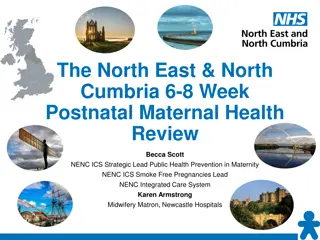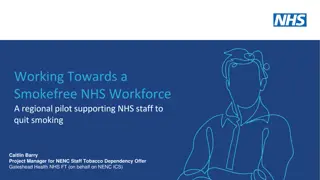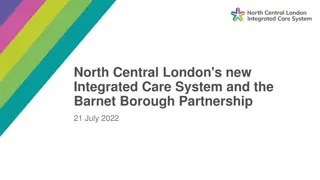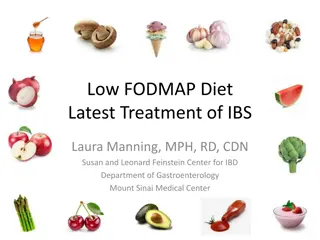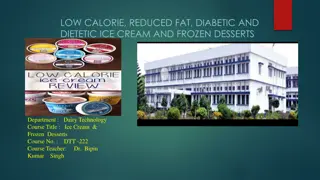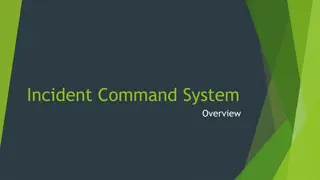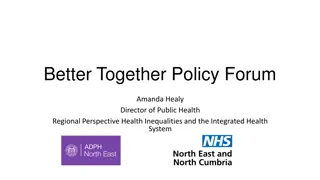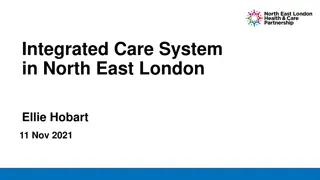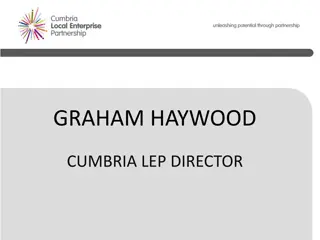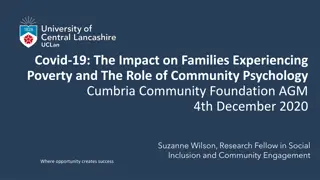North East and North Cumbria ICS Low Calorie Diet Pilot
The North East and North Cumbria ICS Low Calorie Diet Pilot by NHS England and NHS Improvement aims to achieve weight reduction, diabetes remission, and improved health outcomes by implementing a low calorie diet protocol. Eligibility criteria and exclusion factors are established to select suitable participants for the program. Two-year data shows promising remission rates based on weight loss categories. The objective is to support individuals with Type 2 diabetes in achieving sustainable weight loss and improved metabolic control through dietary interventions.
Download Presentation

Please find below an Image/Link to download the presentation.
The content on the website is provided AS IS for your information and personal use only. It may not be sold, licensed, or shared on other websites without obtaining consent from the author.If you encounter any issues during the download, it is possible that the publisher has removed the file from their server.
You are allowed to download the files provided on this website for personal or commercial use, subject to the condition that they are used lawfully. All files are the property of their respective owners.
The content on the website is provided AS IS for your information and personal use only. It may not be sold, licensed, or shared on other websites without obtaining consent from the author.
E N D
Presentation Transcript
North East and North Cumbria ICS Low Calorie Diet Pilot NHS England and NHS Improvement
The evidence The DiRECT trial (2017) Low calorie diet (LCD) using total diet replacement (TDR) Type 2 Diabetes within 6 years of diagnosis All glucose and BP-lowering agents stopped on day 1 of TDR NHS England and NHS Improvement
The Data 2 year data showed remission rates: 64% of people with 10kg loss 29% of people with 5-10kg weight loss 5% of people with <5kg weight loss NHS England and NHS Improvement
The Aims of the Pilot Reduction in weight and maintenance of weight loss Achievement of remission of Type 2 diabetes Reduced HbA1c, BP and cholesterol Reduction in medication usage NHS England and NHS Improvement
Eligibility Criteria Aged 18 to 65 years (inclusive) Diagnosed with Type 2 diabetes in the last 6 years BMI of 27kg/m or higher (25kg/m or higher for BAME participants) HbA1c in the last 12 months: >If on diabetes medication, HbA1c 43-87 mmol/mol >If not on diabetes medication, HbA1c 48-87 mmol/mol Must have attended for monitoring and diabetes review and have attended eye screening when last invited NHS England and NHS Improvement
Exclusion Criteria - HbA1c >87 - Current insulin user - Pregnant or planning to become pregnant within the next 6 months - Currently breastfeeding - Has at least one of the following significant co-morbidities; active cancer Heart attack or stroke in last 6 months Severe heart failure (New York Heart Association grade 3 or 4) Severe renal impairment (most recent eGFR less than 30) Active liver disease (not including NAFLD) Active substance use disorder Active eating disorder Porphyria Known proliferative retinopathy that has not been treated. Recent weight loss of greater than 5% body weight or is currently on a weight management programme Undergone or is awaiting bariatric surgery (unless willing to come off waiting list) - ** NB: Gallstones!!** NHS England and NHS Improvement
Definition of Diabetes in remission HbA1c < 48mmol/mol maintained for at least 6 months (or FPG < 7mmol/l if HbA1c is not clinically suitable) Patient is off all glucose-lowering agents NHS England and NHS Improvement
Remission Practicalities Best to use the term remission not cure Weight gain above an individual s personal fat threshold causes Type 2 Diabetes The TDR phase causes excess fat to be removed from the liver and pancreas Normal physiological function resumes Weight loss needs to be maintained to continue remission Check HbA1c at 6 months and at 12 months following the start of the programme If remission is achieved at 12 months, code as Type 2 Diabetes in remission NHS England and NHS Improvement
What is our role in Primary Care? Run the eligibility searches Respond to any clinical need to further adjust medications according to capillary blood glucose and blood pressure monitoring by Momenta Choose which patients to invite Provide information on remission of Type 2 Diabetes, the LCD service and potential risks and benefits to obtain informed consent Respond to adverse events if patient contacts practice directly with an urgent clinical need or is directed to the GP practice by Momenta Agree medication changes to take place on day 1 of TDR (copy to patient) Arrange review of patient at 6 months and 12 months after starting LCD programme with repeat HbA1c with further medication adjustment as necessary NHS England and NHS Improvement
Inviting patients How do we select the most engaged? What sort of invites ensure they are motivated to engage? What will work for your practice? NHS England and NHS Improvement
The initial consultation What does the person with diabetes already know about the LCD? What made them book this appt to talk about it? Fill in any knowledge gaps in what it involves. Benefits - achieving diabetes in remission - stopping meds - reduction in complications. Risks - BP and glucose could drop too low (so that is why we need to stop meds) - BP or glucose could go too high if you stop meds and don t keep to the diet (suggest to have their own BP meter: blood glucose meter provided). - constipation (will be given fibre supplements) - feeling the cold NHS England and NHS Improvement
What do we need to do about medications and why? NHS England and NHS Improvement
Expected blood glucose and BP changes on TDR (from the Direct trial) NHS England and NHS Improvement
Adverse events Patient concern: Not urgent- patient contacts Momenta who has a medical director to advise Urgent- contact GP practice. Momenta concern re blood glucose: 15-19.9 over 2 sessions- Momenta to contact GP. 20 or higher- same day contact by Momenta and patient. Momenta concern re BP: 90/60 mmHg or lower (systolic and/or diastolic) or postural symptoms Momenta to contact GP (same day if interfering with daily living) 160/100 to 179/119 mmHg (systolic and/or diastolic) at 2 sessions Momenta contact GP 180/120 mmHg or higher (systolic and/or diastolic) same day contact- Momenta and patient. Contact GP NHS England and NHS Improvement
Deprescribing glucose medication Blood glucose levels drop significantly on day 1 of TDR so patient needs to stop meds on day 1 of starting TDR. If on 1 or 2 glucose lowering meds, stop them all. If on 3 or more meds, stop two and continue metformin (or a DPP4i gliptin or pioglitazone if not on metformin) NHS England and NHS Improvement
Glucose deprescribing examples Anja is on metformin Baljit is on metformin and gliclazide Clare is on metformin, empagliflozin, and liraglutide. David is on metformin, sulfonylurea and DPP4 inhibitor Emma is on gliclazide, SGLT2 inhibitor and GLP-1 analogue Franz is on sulfonylurea, SGLT2 inhibitor, and DPP4 inhibitor Gemma is on DPP4 inhibitor, pioglitazone and SGLT2 inhibitor Henri is on metformin, pioglitazone, SGLT2 inhibitor and GLP-1 analogue NHS England and NHS Improvement
Glucose deprescribing answers RED = STOP GREEN= CONTINUE AMBER = CONSIDER BUT CAN CONFOUND OUTCOMES Anja is on metformin Baljit is on metformin and gliclazide Clare is on metformin, empagliflozin, and liraglutide. David is on metformin, sulfonylurea and DPP4 inhibitor (keep 1 green only) Emma is on gliclazide, SGLT2 inhibitor and GLP-1 analogue Franz is on sulfonylurea, SGLT2 inhibitor, and DPP4 inhibitor Gemma is on DPP4 inhibitor, pioglitazone and SGLT2 inhibitor (keep 1 green) Henri is on metformin, pioglitazone, SGLT2 inhibitor and GLP-1 analogue NHS England and NHS Improvement
Restarting glucose medication If Momenta flags that blood glucose is above 15 or HbA1c at 6 or 12 months has risen: Metformin first line and is also safe in TDR Pioglitazone or DPP4 inhibitors are also safe in TDR GLP-1 analogues are safe in TDR and can be restarted, but are high cost and may confound weight loss outcomes Sulfonylureas, meglitinides or SGLT2 inhibitors must not be used during TDR for safety reasons NHS England and NHS Improvement
Glucose re-prescribing examples Alice is on no meds for glycaemia Ben is on metformin (used to be on gliclazide and empagliflozin) and still doing the TDR Clare is on metformin (used to be on empagliflozin, and liraglutide) and just finished TDR NHS England and NHS Improvement
Glucose re-prescribing answers Alice is on no meds for glycaemia: start metformin or if intolerant DPP4i Ben is on metformin (used to be on gliclazide and empagliflozin as well) and still doing the TDR : Gliclazide and empagliflozin can not be restarted as c/i in TDR phase: start DPP4i or if intolerant GLP-1 Clare is on metformin (used to be on empagliflozin and liraglutide as well) and just finished TDR phase: can restart either empagliflozin or liraglutide NHS England and NHS Improvement
Stopping/Adjusting BP Lowering agents Plan for the first day of TDR: If BP is raised (systolic 140mmHg or diastolic 90mmHg), make no changes to BP-lowering agents If blood pressure in range (both systolic < 140mmHg and diastolic < 90mmHg), one BP-lowering agent should be stopped/adjusted on the first day of TDR not before NHS England and NHS Improvement
Which BP medication to adjust? Check notes and check with patient if any of the BP medications are also prescribed for another reason eg nephropathy, angina, heart failure, BPH, migraines Stop the agent that is purely prescribed for BP which would have been added last according to current NICE guidelines. This would be (in order of stopping first): Spironolactone or alpha-blocker or beta-blocker Calcium-channel blocker or Thiazide diuretic ACE-inhibitor or Angiotensin receptor blocker If the patient is taking agents which affect blood pressure but all are being used for other indications then cautiously reduce the dose of one or more agent in discussion with the patient. NHS England and NHS Improvement
BP deprescribing examples Patients A-F have BP in range <140/90. Anja is taking ramipril 10mg (for BP solely no other indications) Baljit is taking ramipril 10mg (for BP solely) and amlodipine 10mg (for BP solely) Claire is taking ramipril10mg (previous MI), amlodipine 10mg (for BP solely), indapamide mr1.5mg (for BP solely), bisoprolol 10mg (previous MI) David is taking ramipril 10mg (for nephropathy) Ed is taking propranolol 40mg bd (for migraine prophylaxis), doxazosin 2mg (for BPH) Franz is taking ramipril 10mg (HFREF), bisoprolol 10mg (HFREF), furosemide 60mg (HFREF) at time of referral Gemma has BP 162/91 on ramipril 5mg, and amlodipine 5mg. NHS England and NHS Improvement
BP deprescribing answers RED = STOP GREEN= CONTINUE AMBER = CONSIDER Patients A-F have BP in range. Anja is taking ramipril 10mg (for BP solely no other indications) Baljit is taking ramipril 10mg (for BP solely) and amlodipine 10mg (for BP solely) Claire is taking ramipril10mg (previous MI), amlodipine 10mg (for BP solely), indapamide mr1.5mg (for BP solely), bisoprolol 10mg (previous MI) stop one red David is taking ramipril 10mg (for nephropathy) reduce dose depending on BP Ed is taking propranolol 40mg bd (for migraine prophylaxis), doxazosin 2mg (for BPH) consider reduce dose of one or both or switch migraine prophylaxis medication Franz is taking ramipril 10mg (HFREF), bisoprolol 10mg (HFREF), furosemide 60mg (HFREF) at time of referral reduce doses of one or more seek advice from HF specialist Gemma has BP 162/91 on ramipril 5mg, and amlodipine 5mg keep both as BP above target maybe able to stop amlodipine once weight loss and BP <140/90 NHS England and NHS Improvement
Further adjustment of BP medication Blood pressure is too low (<90/60 or postural symptoms) Review current medications that affect BP. Stop/reduce the next agent being used solely for managing BP as per NICE guidelines. If on for reasons other than BP alone then reduce/stop one of these agents (may need to seek specialist advice) Blood pressure is too high (160/100 to 179/119 mmHg (systolic and/or diastolic) at 2 sessions OR 180/120 mmHg or higher (systolic and/or diastolic) Restart/ increase any previously stopped/adjusted agents used for other indications (rather than solely for managing blood pressure) first, then any previously stopped/adjusted agents for managing blood pressure alone. Follow NICE guidance for antihypertensive therapy NHS England and NHS Improvement
Further BP adjustment examples Patients A-F BP now too low Anja review again any meds that can lower BP missed? If not usual ix for hypotension and may have to stop LCD Baljit is now only taking ramipril 10mg (for BP solely) having stopped amlodipine so stop ramipril Claire is taking ramipril10mg (previous MI), amlodipine 10mg (for BP solely), indapamide mr1.5mg (for BP solely), bisoprolol 10mg (previous MI) stop one red indapamide or amlodipine stopped initially so now stop the other one- may also need to consider reducing BB depending on response David is taking ramipril 10mg (for nephropathy) reduce dose further if already on lowest dose seek advice Ed is taking propranolol 40mg bd (for migraine prophylaxis), doxazosin 2mg (for BPH) consider reduce dose of one or both or switch migraine prophylaxis medication Franz is taking ramipril 10mg (HFREF), bisoprolol 10mg (HFREF), furosemide 60mg (HFREF) at time of referral reduce doses of one or more seek advice from HF specialist Gemma continued on ramipril 5mg, and amlodipine 5mg stop amlodipine first, then reduce/stop ramipril if BP still too low. NHS England and NHS Improvement
BP deprescribing answers Patients A-F BP now too high Anja restart ramipril and titrate as per usual until BP optimised as on for BP alone Baljit has continued ramipril 10mg (for BP solely), amlodipine 10mg (for BP solely) was stopped restart amlodipine 5mg and increase back to 10mg dependant on BP Claire has continued ramipril10mg (previous MI) and bisoprolol 10mg (previous MI) amlodipine 10mg (for BP solely), or indapamide mr1.5mg (for BP solely) was stopped restart the one that was stopped: if amlodipine restart at 5mg and increase back to 10mg dependant on BP David is taking ramipril 10mg (for nephropathy) increase dose back up Ed is taking propranolol 40mg bd (for migraine prophylaxis), doxazosin 2mg (for BPH) if propranolol was changed for alternative migraine treatment consider starting ACE or Calcium channel blocker if it was reduced try increasing back to 40mg bd Franz is taking ramipril 10mg (HFREF), bisoprolol 10mg (HFREF), furosemide 60mg (HFREF) increase the doses of the agents reduced at the start of the TDR Gemma continued ramipril 5mg, and amlodipine 5mg increase ramipril, then amlodipine if BP still too high NHS England and NHS Improvement
Other medication which might need adjusting Ask yourself: if someone lost significant weight would any medication doses need adjustment? It is the responsibility of the referrer to make sure that processes are in place for any applicable medications to be adjusted. If in doubt, discuss with a pharmacist colleague Liaise with specialist clinic if receiving treatment elsewhere esp if parenteral drug eg biological treatments. Commonly used oral medicines which may require adjustment include: Warfarin advise warfarin clinic patient taking part DOACs Digoxin Phenytoin Ciclosporin NHS England and NHS Improvement
Contact us Lynn Sparrey NENC Clinical Networks Harry Macmillan Momenta Newcastle lynn.sparrey@nhs.net harry.macmillan@momentanewcastle.com Scott Greenwood NHS North of England Commissioning Support Unit scott.greenwood@nhs.net NHS England and NHS Improvement
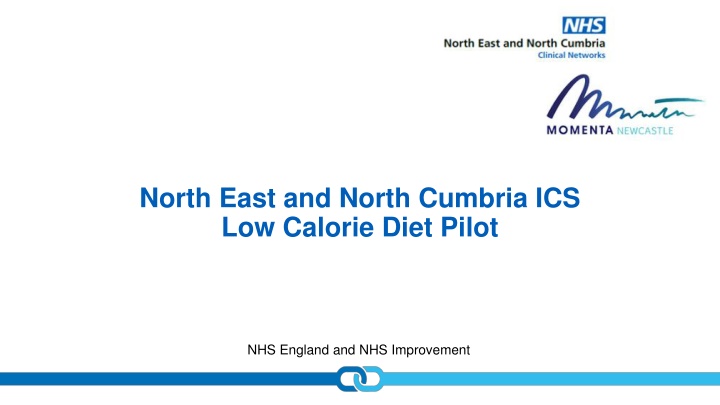

![READ [PDF] Dash diet Cookbook for beginners: 365 days of simple, healthy, low-s](/thumb/2057/read-pdf-dash-diet-cookbook-for-beginners-365-days-of-simple-healthy-low-s.jpg)



